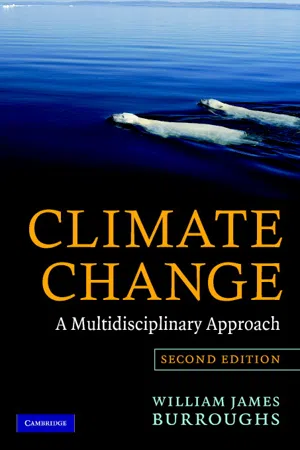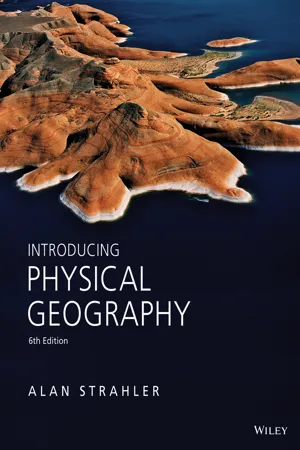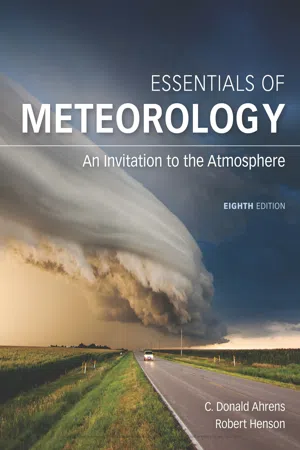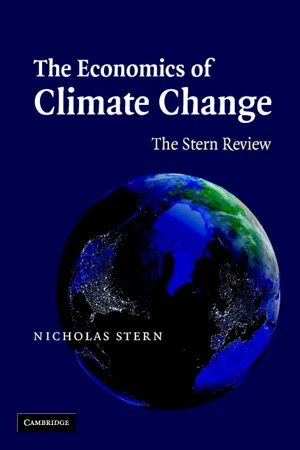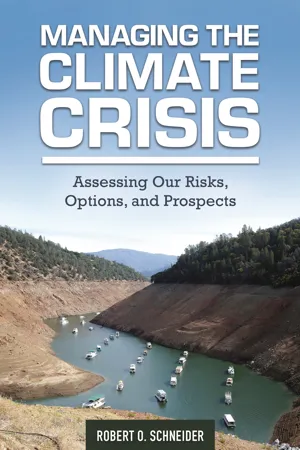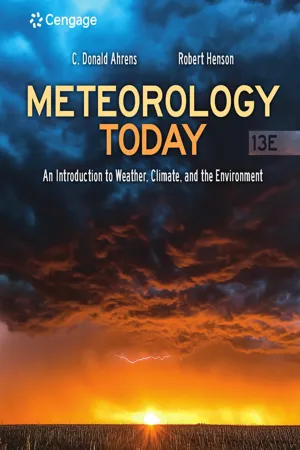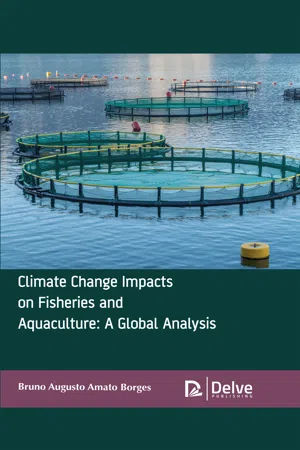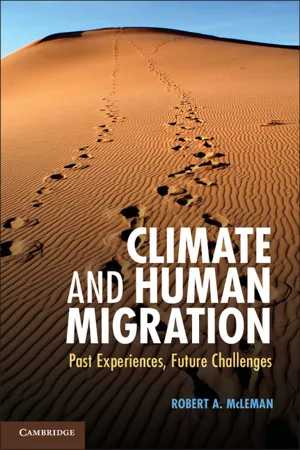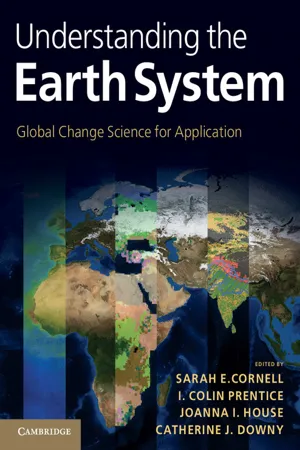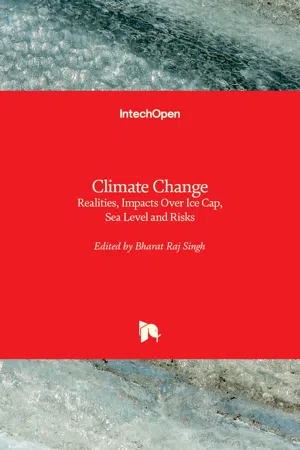Geography
Evidence for Climate Change
Evidence for climate change includes various indicators such as rising global temperatures, melting ice caps, and changing precipitation patterns. These changes are supported by scientific data collected from sources like satellite observations, ice core samples, and historical climate records. The evidence points to human activities, particularly the burning of fossil fuels, as the primary driver of these changes.
Written by Perlego with AI-assistance
Related key terms
1 of 5
11 Key excerpts on "Evidence for Climate Change"
- eBook - PDF
Climate Change
A Multidisciplinary Approach
- William James Burroughs(Author)
- 2007(Publication Date)
- Cambridge University Press(Publisher)
Exploring the evidence of climatic variations over the complete history of the Earth covers processes that have taken an immense time to occur (e.g. continental drift). In terms of current concerns about future changes in the climate these changes seem immeasurably slow and hence of little rele-vance to contemporary issues. This view is short-sighted. An understanding of longer-term changes not only sets current events in context, but also identifies the importance of different components of the global climate (e.g. changes in ocean circulation). So the more we know about what has hap-pened in the past, and why events occurred, the easier it may be to appreciate the questions that need to be addressed today. This catholic approach means we need to be clear what we trying to do in this chapter. The objectives are to identify the principal evidence of climate change and to expose the limitations in our knowledge of what changes have occurred. This approach will prepare the ground for considering the consequences and causes of climate change, and whether we can take a view on how it may change in the future. 8.1 Peering into the abyss of time The science of geology is the key to understanding how the Earth’s climate has undergone huge changes in the past. As geologists started to build up models of how the stratigraphy of the Earth had been laid down over the vastness of time, it became clear that huge changes had occurred in the climate. More recently, it was realised that the distribution of the conti-nents had changed over time. So the interpretation of the climatic clues locked up in the rocks has been a painstaking business. This involved building up a picture of the conditions prevailing at the time the sediments were deposited and whereabouts on the globe these processes took place. 213 8.1 Peering into the abyss of time - eBook - PDF
- Alan H. Strahler(Author)
- 2013(Publication Date)
- Wiley(Publisher)
At other times, the changes are rapid, as when hurricane winds flatten vast areas of forests or even tracts of houses and homes. Environmental change is now produced not only by the natural processes that have acted on our planet for millions of years, but also by human activity. The human race has populated our planet so thoroughly that few places remain free of some form of human impact. Global change, then, involves not only natural processes, but also human processes that interact with them. Physical geography is the key to understanding this interaction. Environment and global change are so important that we open nearly every chapter with a special section titled “Eye on Global Change” to introduce change- related topics. What are some of the important topics of global change that lie within the scope of physical geography? Let’s examine a few. GLOBAL CLIMATE CHANGE Are human activities changing global climate? It seems that almost every year we hear that it has been the hottest year, or one of the hottest years, on record. But climate is notoriously variable. Could such a string of hot years be part of the normal varia- tion? This is the key question facing scientists study- ing global climate change. Over the past decade, nearly all scientists have come to the opinion that human activity has, indeed, begun to change our cli- mate. How has this happened? The answer lies in the greenhouse effect. As human activities continue to release gases that block heat radiation from leaving the Earth, the greenhouse effect intensifies. The most prominent of these gases is CO 2 , which is released by fossil fuel burning. Others include methane (CH 4 ), nitrous oxide (NO), and the chlorofluorocarbons that, until recently, served as coolants in refrigeration and air conditioning systems and as aerosol spray propellants. - eBook - PDF
Essentials of Meteorology
An Invitation to the Atmosphere
- C. Donald Ahrens, Robert Henson(Authors)
- 2017(Publication Date)
- Cengage Learning EMEA(Publisher)
Even small changes can be problematic when averaged over many years, as when grasslands once used for grazing gradually become uninhabited deserts. In this chapter, we will first look at the Evidence for Climate Change in the past; then we will investigate the causes of climate change from both natural processes and human activity. would rise about 66 m (217 ft) (see Fig. 13.2). Imagine the catastrophic results: Many major cities (such as New York, Shanghai, Tokyo, and London) would be inun- dated. Even a rise in global temperature of several degrees Celsius may be enough to raise sea level by a meter or more this century, flooding coastal lowlands and increasing the impact of storm surges. Geological evidence left behind by advancing and retreating glaciers suggests that global climate has under- gone slow but continuous changes. To reconstruct past climates, scientists must examine and then carefully piece together all the available evidence. Unfortunately, the evidence only gives a general understanding of what past climates were like. For example, fossil pollen of a tundra plant collected in a layer of sediment in New England and dated to be 12,000 years old suggests that the climate of that region was much colder than it is today. Other evidence of global climatic change comes from core samples taken from ocean floor sediments and ice from Greenland and Antarctica. A multiuniversity research proj- ect known as CLIMAP (Climate: Long-Range Investigation Mapping and Prediction) has studied the past million years of global climate. Thousands of meters of ocean sediment obtained with a hollow-centered drill were analyzed. This sediment contained the remains of calcium carbonate shells of organisms that once lived near the surface. Because certain organisms can only live within a narrow range of temperature, the distribution and type of organisms within the sediment indicate the temperature of the surface water. - eBook - PDF
The Economics of Climate Change
The Stern Review
- Nicholas Stern(Author)
- 2007(Publication Date)
- Cambridge University Press(Publisher)
Preliminary estimates suggest that the fraction of land area in extreme drought at any one time will increase from 1% to 30% by the end of this century. In other regions, warmer air and warmer oceans are likely to drive more intense storms, particularly hurricanes and typhoons. As the world warms, the risk of abrupt and large-scale changes in the climate system will rise. ● Changes in the distribution of heat around the world are likely to disrupt ocean and atmospheric circulations, leading to large and possibly abrupt shifts in regional weather patterns. ● If the Greenland or West Antarctic Ice Sheets began to melt irreversibly, the rate of sea level rise could more than double, committing the world to an eventual sea level rise of 5–12 m over several centuries. The body of evidence and the growing quantitative assessment of risks are now sufficient to give clear and strong guidance to economists and policy-makers in shaping a response. 1.1 Introduction Understanding the scientific evidence for the human influence on climate is an essential starting point for the economics, both for establishing that there is indeed a problem to be tackled and for comprehending its risk and scale. It is the science that dictates the type of economics and where the analyses should focus, for example, on the economics of risk, the nature of public goods or how to deal with externalities, growth and development and intra- and inter-generational equity. The relevance of these concepts, and others, is discussed in Chapter 2. This chapter begins by describing the changes observed in the Earth’s system, examining briefly the debate over the attribution of these changes to human activ- ities. It is a debate that, after more than a decade of research and discussion, has reached the conclusion there is no other plausible explanation for the observed warming for at least the past 50 years. - eBook - PDF
Managing the Climate Crisis
Assessing Our Risks, Options, and Prospects
- Robert O. Schneider(Author)
- 2015(Publication Date)
- Praeger(Publisher)
CHAPTER 2 What Does the Science Tell Us? Introduction Climate change is not a recent or new phenomenon. The science sur- rounding it is well established, and climatologists have been studying it for over 150 years. The climate is constantly changing due to natu- ral phenomena and, as we shall see, due to human activity as well. Climate change is not necessarily a problem or, as we are suggesting about the current situation, a crisis. Not all natural or anthropogenic (human caused) influences on the climate produce a serious threat. But any climate changes that exceed the norm, that may test the resil- iency of natural ecosystems, can pose difficulties that logically must be noted and addressed. Whether the causes of the difficulty are natu- ral or of human origin, extreme shifts in climate may have negative impacts on all life on the planet. The present scientific consensus sur- rounding the phenomenon of global warming warns us of serious problems about which we should be concerned and constructively engaged. The climate of the earth, by which is meant the average of meteoro- logical conditions over time, does change in the natural course of events. Scientists have been studying the ways the climate changes, both in particular places and for the earth as a whole, since the begin- ning of the 19th century. This includes the most basic of questions. Why is the earth the temperature that it is? What accounts for changes in average temperature or changes in other meteorological measures such as humidity, wind speed, cloud cover, precipitation, and snow and ice cover? What difference does all of this make for life on this planet? The climate impacts people directly, as in the case of damaging 26 Managing the Climate Crisis storms or deadly heat waves, but it also impacts all environmental and ecological processes. Many of these impacts or effects may not be immediately recognizable to us, but they do hold the potential over time to alter our lives significantly. - C. Donald Ahrens, Robert Henson(Authors)
- 2021(Publication Date)
- Cengage Learning EMEA(Publisher)
As the urban environment grows, its climate differs from that of the region around it (see ● Fig. 18.1). Sometimes the dif- ference is striking, as when city nights are warmer than the nights of the outlying rural areas. Other times, the difference is subtle, as when a layer of smoke and haze covers a city. Climate variations such as a persistent drought or a delay in the annual monsoon rains can adversely affect the lives of millions. Even small changes can be problematic when averaged over many years, as when grasslands once used for grazing gradually become uninhabited deserts. In this chapter, we will first look at the evidence for cli- mate change in the past; then we will investigate the causes of climate change from both natural processes and human activity. 18.1 Reconstructing Past Climates LO1 A mere 18,000 years ago, Earth was in the grip of a cold spell, with alpine glaciers extending their icy fingers down river valleys and huge ice sheets (continental glaciers) covering vast areas of North America and Europe (see ● Fig. 18.2). The ice at that time measured several kilometers thick and extended as far south as New York and the Ohio River Valley. The glaciers advanced and retreated more than 20 times during the last 2.5 million years. In the warmer periods between glacier advances, aver- age global temperatures were similar to those at present, even slightly higher in some cases. The advance and retreat of gla- ciers are closely related to variations in how Earth orbits the sun. Research in this area suggests we are likely thousands of years away from the next return of the glaciers. Presently, glaciers cover less than 10 percent of Earth’s land surface. The total volume of ice over the face of Earth amounts to about 30 million cubic kilometers. Most of this ice is in the Green- land and Antarctic ice sheets, and its accumulation over time has allowed scientists to measure past climatic changes.- eBook - PDF
- Ashley Kent(Author)
- 2000(Publication Date)
- SAGE Publications Ltd(Publisher)
INTRODUCTION Planet Earth is intrinsically dynamic, and humans, for their very survival, must be dynamic too, moving, changing and evolving. Stability is never an option. (Moore, Chaloner and Stott, 1996, p. vii) With the emergence of global warming onto the world’s political, social and economic agendas, climatic information and data have been subject to unprecedented scrutiny. Climatic change straddles the physical and human sciences and the contentiousness of our responses to it is heightened when apparently conflicting perspectives are presented. Two questions are fundamental to these arguments: is climate changing? and (if it is), how is it changing? This chapter will start by addressing these questions. Scenarios of future climates will be appraised and a variety of response strategies will be evaluated. This will highlight the challenges of communicating scientific uncertainties to the public and to political decision-makers alike and in encouraging a greater public understanding of environmental change. IS CLIMATE CHANGING? Climate has always changed. For the first hundred years or so of instrumental observations (to about 1900) global climate appeared to be relatively stable over the relatively small part of the world that had climate observing sites (Hulme, 1994; Lamb, 1995). The phenomenon of global warming can only be quantified satisfactorily if data is collected on a global basis. Figure 4.1 shows the widely accepted ‘official’ data-set of sea and land surface temperature compiled by the Climatic Research Unit at the University of East Anglia 1 and the Hadley Centre of the Meteorological Office. 2 This is an amalgam of over 8000 sea surface temperature measurements by shipping and buoys together with over 1000 land temperature observations from conventional climatological stations (Jones, 1994; Parker, Horton and Gordon, 1998). The data are then expressed in terms of a regular grid spacing to give an even geographical coverage. - eBook - PDF
Climate Change Impacts on Fisheries and Aquaculture
A Global Analysis
- Bruno Augusto Amato Borges(Author)
- 2019(Publication Date)
- Delve Publishing(Publisher)
Moreover, the negative effects also are interdependent. For example, drought can cause wildfires which cause destruction of vegetation. Similarly, sea level increases due to melting of glaciers. This in turn affects the marine ecosystem and also impairs economic activities. 1.4.1. Impact of Global Climate Change on Physical Systems The satellites of the Earth and other advancement in technologies have helped scientists to see the vital facts of climate change and collect various types of information about Earth. Thus, database that has been collected overtime has revealed the evidences about global warming. Ice cores drilled out from Antarctica, Greenland, and glaciers show that Earth’s climate is sensitive to GHG levels. Climate Change Impacts on Fisheries and Aquaculture: A Global Analysis 14 There are evidences from ancient times that reveal that the current rate of change is almost ten times faster than the change witnessed while transiting from the ice-age. These evidences include ocean sediments, tree rings, sedimentary rocks, coral reefs, etc. • Global Temperature Increase: The average temperature of the Earth has increased by 1.62°F since the end of 19 th century. This change has caused by emission of carbon dioxide and other emissions due to human activities. The majority of the warming can be traced to the last three to four decades. The five warmest years were since 2010. The year 2016 was the warmest year witnessed till now. Not only this, the months from January to September, except June was the warmest on record for those respective months. There has been an unprecedented increase in heat waves both in terms of severity and frequency. The 2003 heat wave killed almost 70,000 people across Europe. In 2010, 55,00 deaths were witnessed in Moscow. India also experienced deadly heat waves and last year. Pakistan recorded its hottest temperature on May 28 last year when the temperature reached 53.5°C. - eBook - PDF
Climate and Human Migration
Past Experiences, Future Challenges
- Robert A. McLeman(Author)
- 2013(Publication Date)
- Cambridge University Press(Publisher)
These theories and concepts have been drawn from the natural and social sciences and employ a range of quantitative, qualitative, and geospatial imaging methods. This book provides a summary of relevant scholarship on the relationship between climate and migration, and is intended to serve as a starting point for scholars wishing to pur- sue further research in this emerging field. In addition to the basic premise that climate can and does influence migration, sev- eral other basic premises underpin this book, which have been drawn from the current literature on the subject: The influence of climate on migration occurs in concert with cultural, economic, political, • and social factors that are human in origin. Migration can be understood as an outcome of processes by which human populations adapt • to climatic variability and change. Past examples can be used as evidence and learning devices for understanding future link- • ages between climate and migration. When the theories, concepts, and methods used in the often unconnected fields of migration • and climate change research are brought together, they provide a powerful toolkit for the scholar. Before launching this chapter with a review of the longer history of the study of cli- mate and migration, it is worth noting that this book avoids as much as possible mak- ing value-laden judgements of whether migration events are good or bad, desirable or undesirable. There is no shortage of others willing to do so. The perspective taken here is that migration happens. Governments and institutions may wish to control and organize migration to suit their own purposes, as is discussed in Chapter 2, but the reality is that even in regimes where people’s mobility is officially restricted, people will migrate when it is in their interest to do so. - eBook - PDF
Understanding the Earth System
Global Change Science for Application
- Sarah E. Cornell, I. Colin Prentice, Joanna I. House, Catherine J. Downy(Authors)
- 2012(Publication Date)
- Cambridge University Press(Publisher)
Satellite altimetry provides global coverage, although precise calibration against tide gauges is required. All these information sources have their own meth- odological challenges affecting the level of confidence in observed changes. A persistent difficulty for glo- bal change science is that the coverage of site-specific studies is far from globally uniform. In many cases, the land-based records are mainly in Europe and North America. Research and policy interest in specific eco- systems means there there are some in high latitudes and the tropics too, but data gaps remain in large areas, notably much of Africa and central and southern Asia. Also, some sites have records extending back several decades, or in exceptional cases centuries, while others have only recent or temporally sparse data. Thus, the various types of site-specific record share the common challenge of trying to establish a large-scale signal from a patchy evidence base. When it comes to ‘observing’ socio-economic impacts, on the one hand there is a long-standing and very well-administered process in almost all countries of tracking many sorts of social and economic measures. On the other hand, as noted earlier, we are concerned with socio-economic impacts arising from environ- mental change, so they have a biophysical component nested within them – but they also depend on human factors. We illustrate the challenge that this presents with the example of impacts linked to drought. Human society depends fundamentally on its agricultural systems for its food security, so climate impacts in this sector are an area of very great inter- est. If drought becomes more frequent, or drought events more extreme, the viability of agriculture can be affected; with implications for national economies, public health, and migration pressures (when com- munities depending on subsistence agriculture seek to move elsewhere). Holton et al. (2003) pointed out that ‘the importance of drought lies in its impacts. - eBook - PDF
Climate Change
Realities, Impacts Over Ice Cap, Sea Level and Risks
- Bharat Raj Singh(Author)
- 2013(Publication Date)
- IntechOpen(Publisher)
Beyond a week or two individual weather systems are unpredictable. Climate - It refers to the average weather in terms of the mean and its variability over a certain time-span and a certain area. Classical climatology provides a classification and © 2013 Singh and Singh, licensee InTech. This is a paper distributed under the terms of the Creative Commons Attribution License (http://creativecommons.org/licenses/by/3.0), which permits unrestricted use, distribution, and reproduction in any medium, provided the original work is properly cited. Climate Change – Realities, Impacts Over Ice Cap, Sea Level and Risks 40 description of the various climate regimes found on the Earth. It varies from place to place, depending on latitude, distance to the sea, vegetation, presence or absence of mountains or other geographical factors. Climate also varies with time; from season to season, year to year, decade to decade or on much longer time-scales, such as the Ice Ages. Statistically significant variations of the mean state of the climate or of its variability, typically persisting for decades or longer, are referred to as climate change. Climate variations and change, caused by external factors, may be partly predictable, particularly on the larger, continental and global, spatial scales. Because human activities, such as the emission of greenhouse gases or change in land-use, do result in external forces, it is believed that the large-scale aspects of human-induced climate change are also partly predictable. However the ability to actually do so is limited because we cannot accurately predict population change, economic change, technological development, and other relevant characteristics of future human activity. Therefore, one has to rely on carefully constructed scenarios of human behaviour and determine climate projections on the basis of such scenarios.
Index pages curate the most relevant extracts from our library of academic textbooks. They’ve been created using an in-house natural language model (NLM), each adding context and meaning to key research topics.
